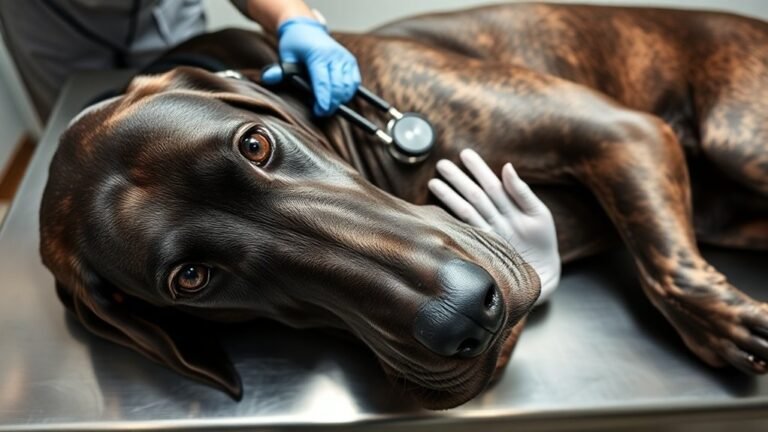Xylitol Sounds Fancy, but It’s Danger in Disguise
Great Danes & Toxins
Hey there, fellow dog lovers! It’s me, your friendly neighborhood Great Dane, and I need to have a serious talk with you about something that affects us giant pups in a big way – toxins!
Now, I know what you’re thinking. “But you’re such a big dog! Surely a little bit of chocolate won’t hurt?” Well, let me tell you, my massive size works against me here. My body processes nasty stuff differently than my smaller doggy friends, and my special Great Dane genes make me extra sensitive to things that could poison me.
Let’s talk about the stuff in your kitchen that makes my tail stop wagging. Chocolate might smell amazing to my super-nose, but it’s basically kryptonite for dogs like me. And don’t even get me started on grapes – they look so innocent and juicy, but they’re terrible for us pups. Onions make me cry for all the wrong reasons (and not just because they’re stinky), and that fake sugar stuff called xylitol? It’s sneaky and dangerous!
But the scary stuff isn’t just in your pantry. Those cleaning supplies under your sink smell weird for a good reason – they’re toxic! And when I’m romping around in the yard with my long legs, I might accidentally munch on plants that could make me sick.
Here’s how you’ll know if I’ve gotten into something I shouldn’t have: I might throw up (sorry about your carpet), act super tired when I’m usually bouncing around, or seem “off.” Trust me, you’ll know something’s wrong because I won’t be my usual goofy, lovable self.
The good news? You can keep me safe! Just remember that this gentle giant needs extra protection from the toxic stuff out there.
Understanding Toxin Sensitivity in Great Danes
Now, I know what you’re thinking: “But you’re just a dog! What do you know about science?” Well, let me tell you, when you’re as big as I am, you learn a thing or two about how your body works! Additionally, I’ve overheard numerous vet visits.
Because I’m so much bigger than, say, a Chihuahua (who I could accidentally step on – sorry, little guys!), my body processes things differently. You might think that being bigger means toxins would affect me less, but that’s not always true. Sometimes my size works against me because my metabolism – that’s the fancy term for how fast my body burns energy – can cause certain unhealthy substances to linger longer or affect me more severely.
Here’s the really interesting part: I’ve got some special Great Dane genes that make me react to toxins in my own unique way. It’s like having a secret family recipe, except instead of making amazing cookies, it determines how my liver and kidneys handle the yucky stuff I shouldn’t eat (but sometimes do anyway because, let’s be honest, that garbage smells really interesting).
Some of my Great Dane cousins and I are more sensitive to certain medications and chemicals than other dog breeds. It’s not our fault – we’re just built this way! Think of it like how some people can’t eat peanuts while others can eat them all day long.
So please, dear humans, keep this in mind when you’re putting chemicals around the house or when the vet wants to give me medicine. What works for a Golden Retriever might knock me flat on my giant behind! Always tell the vet that I’m a Great Dane – trust me, it matters more than you think.
The bottom line is this: I may look tough and intimidating (until I try to sit in your lap like a tiny puppy), but I need you to be extra careful about what I’m exposed to. Keep those cleaning supplies locked up, watch what you drop on the floor, and remember that this big guy has some special needs when it comes to staying safe and healthy. Being aware of toxic plants is crucial for my protection and well-being.
After all, I’ve got important work to do – like protecting the house from delivery trucks and keeping the couch warm!
Common Food Toxins That Affect Great Danes
Now, I know what you’re thinking – “Yeti, you’re huge! Can’t you eat anything?” Well, turns out size doesn’t matter when it comes to certain foods that can make us really sick. My humans learned this lesson when I got into some chocolate last Christmas. Let’s say it wasn’t my finest hour, and I spent way too much time at the vet instead of opening presents.
So here’s the scoop from someone who’s been there: certain human foods might smell amazing, but can turn our bellies into a disaster zone. Some might give us an upset stomach, but others can be hazardous. The good news is that once you know what to watch out for, keeping us safe is pretty easy.
My humans learned a valuable lesson after my chocolate incident and discovered which foods are toxic to dogs like me. Now I’m passing that wisdom on to you because nobody wants to miss out on belly rubs due to a food emergency! Awareness of potential hazards is crucial for keeping Great Danes like me healthy and happy.
Symptoms of Ingestion
Symptoms of Ingestion
Woof! Let me tell you something important from a Great Dane who’s been around the block (and the kitchen counter). Us big dogs sometimes eat things we shouldn’t, and trust me, our humans need to know the warning signs when we do something dumb.
I’ve learned that spotting these symptoms early can save us from a really ruff day. When we consume the wrong things, our bodies let us know pretty quickly. The most common signs are throwing up, having messy bathroom breaks, feeling super tired, and drooling like we just saw a giant steak.
My human keeps this handy chart on the fridge, and honestly, it’s saved my tail more than once:
| What’s Wrong With Me | What I Probably Ate | What My Human Should Do |
|---|---|---|
| Throwing up | That chocolate I found | Call the vet right now |
| Messy poops | Onions from dinner | Make sure I drink water |
| Can’t keep my eyes open | Those grapes I snatched | Get me to the vet fast |
| Drooling like a waterfall | Gum with xylitol | Maybe make me throw up (but only if the vet says so) |
Look, I know us Great Danes are basically walking garbage disposals with legs, but our humans really need to watch for these signs. We might be big, but we’re also big babies when we eat the wrong stuff! Remember, closely monitoring symptoms can help identify issues before they become serious.
Environmental and Contact Toxins Impacting Great Danes
So here’s the deal: our homes and yards are full of things that smell interesting but could really mess us up. I’m talking about those cleaning bottles under the sink that smell like they could strip paint (spoiler alert: they probably can).
And don’t get me started on whatever’s lurking in the dirt outside – apparently, there are tiny bad guys called bacteria just waiting to crash our belly party. Well, my giant friend, even us gentle giants can get knocked down by this invisible nasty stuff.
These toxins don’t care if we can reach the kitchen counter without jumping – they’ll still make us feel terrible and could even make our awesome lives shorter. In fact, environmental factors like allergens and toxins can compromise our skin’s protective barrier, leading to a higher risk of infections.
The good news? Our humans can help keep us safe if they know what to look out for. We just need to work together to spot the dangerous stuff before it spots us.
After all, we’ve got important napping and treat-eating to do!
Household Chemical Hazards
Those cleaning sprays you love so much? They smell terrible to my super-nose, and they can make me really sick. The same goes for those air fresheners you plug into the wall. I mean, come on – my natural doggy smell isn’t THAT bad, right?
Here’s the thing about us Great Danes – we might look like gentle giants, but we’re pretty sensitive. Our big bodies can absorb more of those toxic chemicals, which is definitely not good news for dogs like me. Early socialization can help us cope better with various environments, but it won’t protect us from harmful substances.
But don’t worry! I’ve got some paw-some solutions. Instead of those harsh cleaners, try using vinegar and baking soda. They work great, and I won’t have to run to another room when you’re cleaning.
You can even use some essential oils that smell way better than those fake flowery sprays.
Trust me, keeping your house clean doesn’t have to mean poisoning your four-legged family members. My health is worth way more than having the shiniest floors in the neighborhood. Plus, I promise to try not to drool on them right after you finish cleaning!
Keep those paws and chemicals separated, friends!
Soil-Borne Bacterial Toxins
So you humans are always worried about your cleaning supplies and stuff, but guess what? There’s some pretty nasty stuff lurking right in our favorite digging spots! As a Great Dane, I know a thing or two about rolling around in dirt (it’s one of my specialties), but apparently, some soil has these invisible troublemakers called bacteria.
These little villains have scary names like Clostridium and Salmonella – sounds like something from a monster movie, right? They love hanging out in contaminated soil, waiting to cause tummy troubles and make us feel awful.
And here I thought the worst thing about dirt was having to take a bath afterward!
The problem is, when I’m having a blast digging the perfect hole or giving myself a good dirt bath, I might accidentally munch on these microscopic meanies. Trust me, they taste way worse than they sound, and they can make my belly feel terrible.
My humans have learned that they should test our soil periodically and ensure I’m clean after my outdoor adventures. I’m not thrilled about the extra baths, but I suppose it’s better than feeling sick! Heavy-duty weatherstripping around the pet door is one way to prevent contaminants from entering our home.
Plus, it means I can continue to enjoy my favorite hobby – transforming our pristine backyard into my personal excavation site!
Clinical Signs of Toxin Exposure in Great Danes
Woof! Let me tell you about something super important – what happens when us Great Danes get into stuff we shouldn’t eat (and trust me, we’re pretty good at finding trouble!).
So picture this: I just scarfed down something that looked delicious, but it turns out not to be so great for my giant body. The first signs that I’m in trouble usually appear quickly – within a few hours. My humans might notice I’m throwing up, having tummy troubles, or just lying around looking pretty miserable instead of my usual bouncy self.
If things get terrible, I might start shaking like I’m cold (but I’m not), or even have scary episodes where I can’t control my body. Sometimes it gets hard for me to breathe properly, which is definitely when my humans need to panic a little bit.
Here’s the thing – if my people can figure out what I got into, it really helps the vet know how to help me. Did I raid the chocolate stash? Get into the garage chemicals? Munch on some weird plant in the yard? The faster they can solve the mystery, the better.
The most important thing is getting me to the vet as quickly as possible when my humans think I’ve eaten something bad. Time really matters when you’re a 150-pound dog who thinks everything might be food! My humans knowing these warning signs means they can help save my bacon (mmm, bacon…). Additionally, being aware of my vulnerable immune system can help them understand how quickly I might react to toxins.
Prevention Strategies for Reducing Toxin Risks
Woof! How to Keep Us Great Danes Safe from Icky Stuff
Here’s what you need to do to keep me and my giant paws out of trouble:
1. Play Detective Around the House: You humans need to put on your detective hats and look around for scary things like poisonous plants (I might think they’re salad), cleaning bottles (they smell weird but I’m curious), and other yucky chemicals.
I’m tall enough to reach stuff you forget about, so check those high shelves too!
2. Lock Up the Dangerous Stuff: Please, please, PLEASE put all your cleaning supplies, pills, and toxic things where my super-long snout can’t reach them. I know I look innocent, but sometimes I get bored and decide to investigate things with my mouth.
Not my best decision-making skill!
3. Teach Everyone in Our Pack: Make sure every human in our family knows what could hurt me. Even the little humans need to learn!
When everyone knows the rules, I stay safe, and you don’t have to worry about me getting into trouble.
Research Insights on Great Dane Toxicology
Hey there, fellow humans! It’s me, your friendly neighborhood Great Dane, and I need to have a serious talk with you about all the stuff that could make me really sick. Don’t worry, though – I’ll do my best to keep it fun while we learn together!
So here’s the thing – us Great Danes are pretty special, and not just because we’re basically the size of small horses. We also have some unique ways our bodies react to dangerous stuff, and I really need you to know about them so you can keep me safe and healthy.
| Dangerous Stuff | What Happens to Me | Why I’m Extra Vulnerable |
|---|---|---|
| Chocolate | I throw up and might have seizures | My big body processes it badly |
| Grapes/Raisins | My kidneys could stop working | We Great Danes are super sensitive |
| Xylitol (sugar substitute) | My blood sugar crashes hard | I react way worse than other dogs |
| Certain Plants | My tummy gets really upset | Some plants hit us giants harder |
| Heavy Metals | My brain gets all mixed up | The bad stuff builds up in my system |
I’m not trying to be a party pooper here, but knowing this stuff helps you make smart choices about what I can and can’t have. Plus, it means more years of me accidentally knocking things off your coffee table with my enthusiastic tail wags!
Trust me, keeping this info in your back pocket will help both of us sleep better at night.
Final Thoughts
Woof! Listen up, fellow Great Danes – we need to talk about all the sneaky stuff that can make us sick. Trust me, I’ve learned this the hard way after trying to eat everything in sight (which, let’s be honest, is what we do best).
First things first – our humans need to keep certain foods away from our giant mouths. I know that chocolate smells amazing, but it’s basically poison for us. The same goes for grapes, onions, and that sugar-free gum stuff. I learned this after my human caught me eyeing their sandwich and gave me the longest lecture ever.
Then there are all those weird chemicals around the house. Cleaning supplies, bug sprays, and antifreeze might look interesting, but they’re definitely not doggy treats. I made the mistake of sniffing some floor cleaner once, and let me tell you – my nose was NOT happy.
We also need to watch out for plants in the yard. Some flowers and bushes are pretty but dangerous. My cousin Daphne once ate some unusual berries and spent the whole day feeling unwell.
The good news? Our humans can learn the warning signs when we’re not feeling well. If we’re acting weird, throwing up, or just not our usual goofy selves, they’ll know something’s wrong.
So here’s the deal – we need to work together with our humans to stay safe. They’ll dog-proof the house, and we’ll try not to eat everything we find. Deal? Our health keeps them happy, and their happiness means more belly rubs for us!







4 Comments